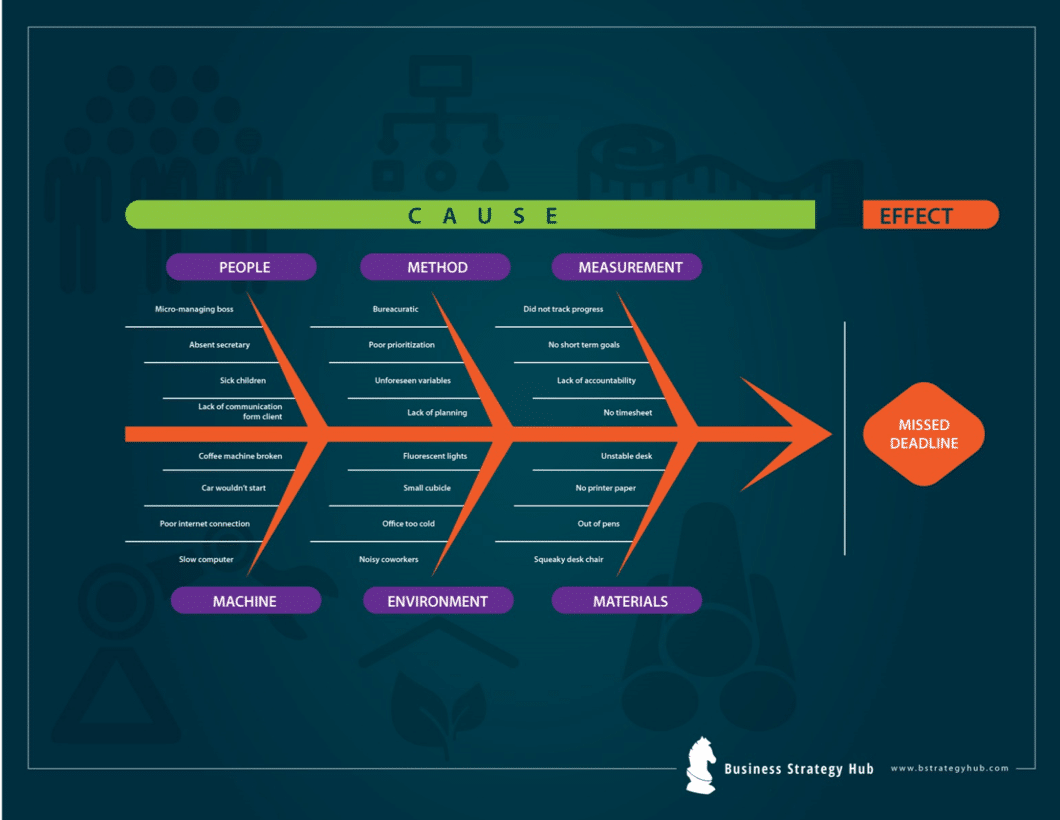Last updated: Feb 22, 2020
Model Name : Fishbone Diagram
Creator : Kaoru Ishikawa
Year : 1986
Purpose : The purpose of a fishbone diagram is to find a solution to a problem through a visualization tool. These tools help in identifying and categorizing the possible solutions of a problem to identify the base of all the causes – the root cause.
What is the Fishbone Diagram?
The fishbone diagram was introduced by Kaoru Ishikawa to act as an indicator which points towards the factors that induce an event to take place.
This diagram gained popularity back in the 80s, and Ishikawa, the man behind the idea, was known as one of the most prominent change-influencers in modern management.
What does the Fishbone Diagram point out?
Which situations require the use of the Fishbone Diagram?
Fishbone diagram is generally used by product designers to reach a better solution, without wasting much time. Other than that, this diagram is used in:
- Figuring out the trouble-inducing issues of a problem,
- Shedding light on the root cause behind an idea that is failing to find a direction.
To analyze the problem better, Fishbone lets you ask the following ‘Whys’:
- Why define?
- Why Measure?
- Why Analyze?
- Why Improve?
- Why Control?
Asking the following 5 whys, one can very easily figure out:
- The root cause of the problem
- How different problems are interlinked with one another
- And gather tons of reliable information without having to perform meticulous calculations.
Knowing what the ‘fish’ represents in the fishbone diagram!
The Ishikawa diagram looks like a fish and consists of many pointers (or fish bones) that lead you out of a state of confusion, and towards a solution.
Below is the list of issues catered through this diagram:
- The head of the fish which is pointing to the right depicts the fault.
- The fish bones extending to the left depict the causes
- The ribs of the fish are drawn as the major causes, where the sub-causes keep adding up depending on the number of causes.
How is the procedure behind Fishbone Diagram carried out?
- After the identification of the problem, comes the step where the problem identifier can really bring out his inner artist. The second half of the process consists of a drawing board and drawing pens and a whole bunch of pointers that are creating a disruption in the flow of any task being carried out. Other than having these two basic items, the fishbone diagram comes together when:
- A statement is identified as the problem that is to be discussed. To look into it further, write down the statement in the center of a blank paper, scrawl a circle around it and make an arrow pointing towards it.
- Proceed by writing down the major issues related to the problem which you have previously stated. To keep things simple, use familiar language so that reaching down to the solution becomes easy for you.
- Assign categories to the written issues and branch them with the previously drawn arrow.
- Verbally discuss the potential solutions of the stated problem with others in the discussion and write each solution down so they can later be placed into their respective category.
- Ensure to throw in the “Who, what, why and how” questions so that the attendees of the discussion can create more and more solutions that way.
Tips to conduct a successful Root Cause Analysis or Fishbone Diagram
- The best way to conclude a problem-analyzing activity is by calling the discussion off with a question.
- Assign responsibilities to the people and make a summary of the entire event that has been conducted. The summary should include every little detail that took place, for example, actions, notes, information regarding the transaction made (if any).
- Other than that, the employees should frequently be asked about their opinions regarding the event. A check on the status of the problem should be frequently done to ensure that nothing is taking place behind schedule.
- The conductor of the analysis (diagram) should keep in mind that every information included should follow 2 of the 7c’s of communication, i.e., clarity and conciseness. This way, the rest of the members who have participated have less trouble figuring out what’s happening.
- An interactive approach should be made, and large problem-solving boards should be placed across the workplace. This will enable the employees to have a look at the problem right at the beginning of their day, so they can know which problem they are addressing for the day.
Example of Fishbone Diagram
Mentioned below is a fishbone diagram of time management:
Concluding the Fishbone Diagram
The Root Cause Analysis, which is also known as the Ishikawa diagram or the fishbone diagram, is undoubtedly gaining heaps and heaps of popularity in a number of industries.
Being an investigational approach to problems, the fishbone diagram revolves around the orthodox perception in whichever field it is targeting.
Through this particular method of solution finding, businesses can find out new methodologies and tactics to deal with any sort of issue, which seems intimidating and difficult to tackle down.
Read More: Learn how to perform SWOT analysis and Gap analysis – these are additional great analytical tools.
References & more information
- Retrieved from www.wikipedia.com














Add comment